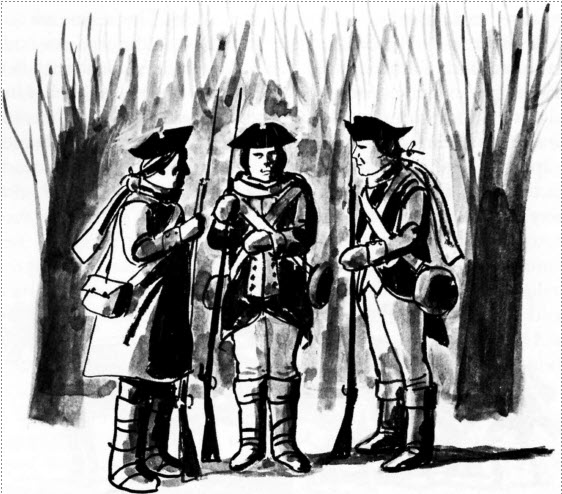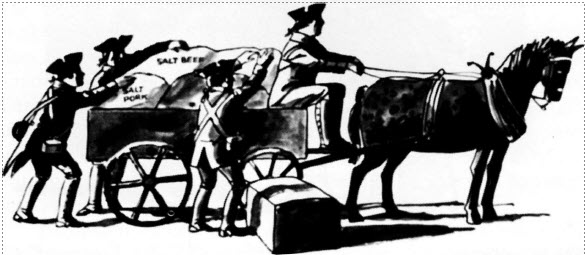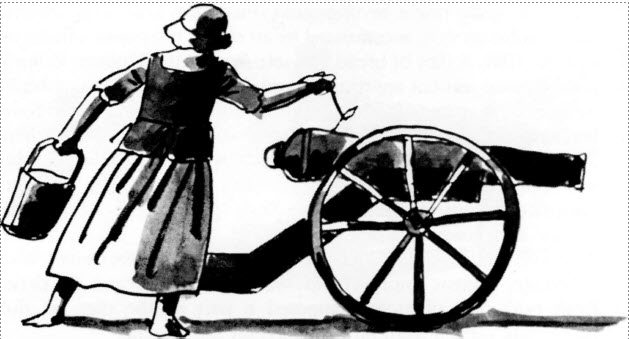The Revolutionary Soldier in Washington's Army
Edward C. Cass
[Editor's Note: This article appeared in the 1981 Issue of the Journal of the Orange County Historical Society. It is being republished on the website as part of the ongoing activities surrounding the 250th Anniversary of the Revolutionary War. The footnoted version is contained in the 1981 Journal which is available for purchase. JAC]
The young soldier of the Revolution faced the ennui and terror, hunger, thirst and repletion that the front-line soldier of any century faces. His father was a farmer or a craftsman and he himself had acquired some training as a farmer or perhaps in his father's craft. Some were accompanied by their older brothers or by their fathers, men who might find use for their skills as wheelwrights, carpenters or blacksmiths. The army that Washington forged required contemporary technology for care of its firearms, swords, bayonets, field pieces, carriages and boats.

Shelter
Permanent cantonments were laid out whenever necessary and the men set to building cabins while they lived in tents. The quartermasters would mark out the prescribed locations on the ground; groups of four cabins with six to eight feet between each group were laid out. The soldiers would obtain the necessary saws, frows, augers and other tools, by theft if necessary, and cut and haul logs for the cabins. Chimneys of “wattle and daub”, sticks covered with clay, were erected. Roofs were timbers covered with hewn slabs. The single room huts would hold ten or twelve men and the ubiquitous straw would serve as mattresses on raised bunks.
Officers' cabins were divided into two rooms and served three or four officers. At some locations, such as West Point, barracks were built. In the fall of 1780 a set of old rat-infested barracks there were replaced by new ones. The soldiers cut wood and rafted it from a point six miles down river; carpenters did the actual construction. For a time the officers continued to live in tents lined with boards and fitted with makeshift fireplaces, but the men were able to move into their new barracks in late October.
The problem of shelter was not always easily solved; the soldiers at Valley Forge suffered extreme distress and only the absence of deep snows and heavy rains that winter allowed the army to survive. The winter of 1779-1780 was worse and was one of the most severe on record, but by then some improvements in providing for the soldiers had been made. Perhaps the new barracks at West Point were built in late 1780 as a result of the extreme weather conditions.
Food
The second basic need, food, was more difficult to satisfy than shelter. Daily rations were supposed to include up to a pound of fresh or salt beef or three-fourths of a pound of salt pork, a pound of flour or its equivalent in bread, and a gill of liquor each day plus salt, vinegar, soap and candles. Butter, milk, beer, and peas or beans might also be included in the ration. This seems adequate until one recalls Washington's comment that the soldiers had to eat every kind of horse fodder except hay. Indeed, delicacies in the field might include a sheep's head, or a boiled squirrel skin as substitutes for regular fare. Baroness von Riedesel was told Americans lived on horseflesh and cats; from the extant documents it appears cats, at least, were safe. The soldiers were very glad to get food like the succotash one prisoner, a British General, threw away as fit for hogs.

Many times soldiers were pleased to receive any food at all even if the beef ration might be half bone and not full weight. On marches the meat would be broiled on a stick and the flour ration, made into dough, would be cooked on a flat rock. "Found" turnips, chestnuts, and black walnuts might supplement such a diet. The Americans, too, had their food preferences: when they overran a German camp the salt herring left behind was tasted and said to be "miserable food ... caught soon after (the) flood". It should be no surprise that loose geese, turkeys or chickens found their way into the ranks under such conditions. The Valley Forge winter provides an example of a period when food supplies were at their lowest. A December thanksgiving celebration brought the troops a half-gill of rice and a tablespoonful of vinegar. A pumpkin, cooked by setting it on a rock and building a fire over it, was another meal for one soldier. The motto of Valley Forge was "fire, cake and water."
In the latter part of the war food distribution improved, but the soldiers remained convinced that much of their salt beef was horsemeat; some felt Hudson River Valley sturgeon or "Albany beef" was worse than horse. On Constitution Island squirrels, and what were probably passenger pigeons, supplemented the diet. During the severe winter of 1779-1780, four to six foot snows cut off West Point and its environs, and at times no food was delivered at all. The cold was said to be enough to cut a man in two. A reduced ration of a pound of meat in five days and no rations for some periods meant the men were seriously weakened, according to one West Point physician. Dog, birch bark and old shoes found a part in the diet in these desperate conditions.
When supplies did arrive the grain might be unground since local mills were frozen. Such problems were accentuated by an ebb in the public's finances in early 1780. A diet of bread and salt shad in the Hudson Valley's summer heat was not appreciated and short rations were a problem into the next winter. It is doubtful the hungry soldiers would have been better pleased by the rice and frog diet of the southern soldier. The availability of peaches and berries supplemented their diet the way apples did in the north. Only towards the end of the war were adequate rations available to the West Point Garrison and the "tripes and cowheels" fare disappeared. In New Jersey, a 1782 Thanksgiving meal included "slapjacks" or flapjacks, honey and chocolate, a great improvement over rice and vinegar. By then, fresh pork and potatoes composed a part of the diet, as did buttermilk begged from farms passed on the march.
Clothing
Clothing distribution was often not much better than food. In 1777 two-thirds of Washington's force was barefoot or virtually so. By the end of 1777 shirts and blankets were also wearing out and few replacements were available. Some soldiers made moccasins from raw cowhide but these chafed the ankles. Even when clothing was received from the states and issued, some men on detached duty would miss out. New blankets, often the only bedding, and issued one per man, might prove to be only two-thirds the proper size.
Camp Followers
Once the clothing, food, and shelter were available, a soldier's thought might turn to the women who were with the armies. Some were wives of enlisted men with no surety of subsistence unless they stayed near their husbands. Others were prostitutes, but these were relatively few since an army with little food and less money was unattractive. Regulations were aimed at discouraging such activities since they were felt to detract from the purity of the cause.

Soldiers' wives experienced the same privations their husbands did and even went into battle, either intentionally or inadvertently. Mary Hayes, also known as "Captain" Molly Pitcher, served a cannon when her husband collapsed at his post. She had been carrying water to the men. The "Captain" smoked, chewed, swore and made crude jokes. That she did so should not detract from her services nor those of the women who served as nurses for the sick and wounded behind the lines. When the war ended, many women, along with their war-born children, faced abandonment when their soldier-husbands were unable or unwilling to keep their "companions during the war".
Next Issue of Journal!
The Next Issue of the OCHS Journal is now accepting articles for consideration.
Authors
More guidelines for authors
Classics from the Journal
NEW!! General Richard Montgomery - Hero of Two Nations
by Marc Newman
NEW!! Joseph Brant and the Battle of Minisink
by Donald F. Clark
NEW!! John Hathorn - American Patriot
by Richard W. Hull
The New Windsor Artillery Park, 1780-1781 - Part I
by Michael S. McGurty
The New Windsor Artillery Park, 1780-1781 - Part II
by Michael S. McGurty
Orange County Militia During the American Revolutionary War
by Alan Aimone
George Washington's Masonic Activities in Orange County
by Andrew J. Zarutskie
Prisoners of War in Goshen
by Harold J. Jonas
John Robinson of Newburgh
by Margaret V. S. Wallace
The Battle of Fort Montgomery
by Donald F. Clark
Role of Regional Revolutionary Women
by Michelle P. Figliomeni
Robert R. Burnet (1762-1854)- The Last Continental Officer
by Alan C. Aimone and Barbara A. Aimone
The Revolutionary Soldier in Washington's Army
by Edward C. Cass
Technical Communication in the Amercan Revolution
by Carol Siri Johnson
New Windsor Cantonment
by E. Jane Townsend
Sidman's Bridge
by Kenneth R. Rose
Corridor Through the Mountains
by Richard Koke
Lydia Sayer Hasbrouck and "The Sybil"
by Amy Kesselman
The Store at Coldengham (1767-1768)
by Jay A. Campbell

